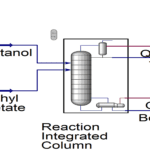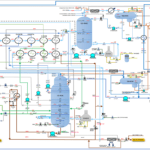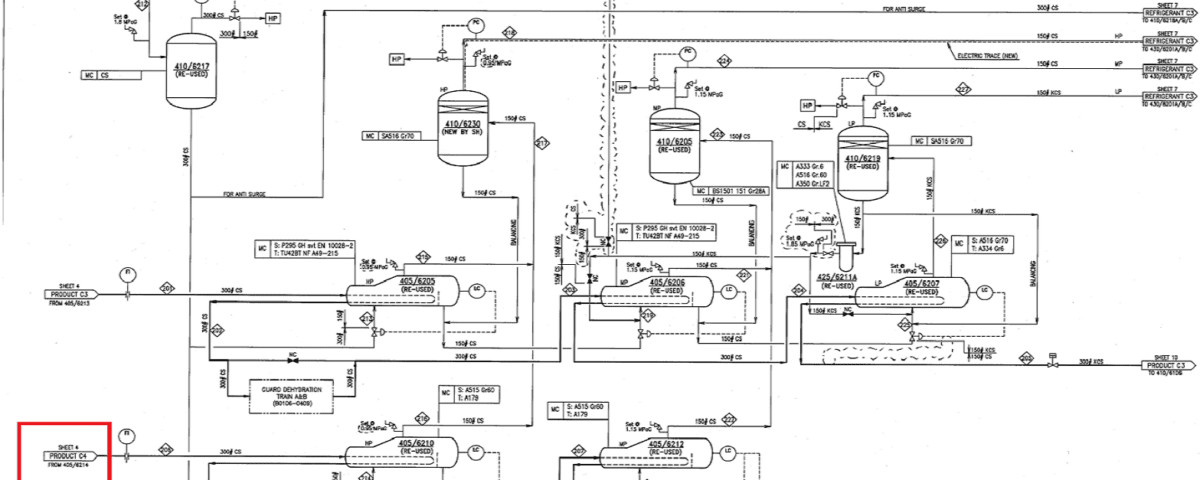Introduction
The simulation and optimization of the C4 refrigeration unit is a key project for APIPCO, commissioned by Sonatrach, the giant energy company of Algeria. The main goal of this project was to accurately simulate and optimize the operation of the C4 refrigeration unit in the natural gas liquefaction process using the advanced software Aspen HYSYS. This project holds significant importance due to the complex engineering processes involved and the necessity to align fully with global standards.
This project is one of the main components in the gas liquefaction chain that aids in enhancing Sonatrach’s efficiency and reducing operational costs. The use of dynamic models and advanced optimization methods allowed for precise simulation of all stages in the refrigeration unit and the determination of optimal performance points. This simulation is not only applicable for improving the current process but can also serve as a model for other similar projects.
Introduction to Sonatrach
Sonatrach, as the largest national oil and gas company in Algeria, is a major player in the global energy industry, both domestically and internationally. The company operates in the exploration, extraction, production, and export of oil and natural gas, contributing significantly to Algeria’s national revenue. With advanced infrastructure and an efficient engineering team, Sonatrach has successfully completed large-scale projects in the oil and gas sector.
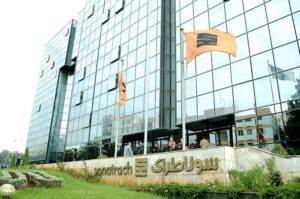
The company is also recognized as a key hub in the liquefied natural gas (LNG) sector and is continuously seeking to enhance its global market share by focusing on process optimization and production efficiency. Given the importance of LNG storage and export, Sonatrach has made significant investments in this area, and projects such as the C4 refrigeration unit demonstrate the company’s commitment to utilizing modern technologies.
C4 Refrigeration Unit Process Overview
The C4 refrigeration unit is a crucial part of the LNG (liquefied natural gas) production process. This unit uses complex compression and refrigeration systems to create suitable conditions for converting natural gas from gaseous to liquid state. The importance of this unit in the LNG production chain is critical, as its efficiency and precision directly impact product quality, energy consumption, and operational costs.
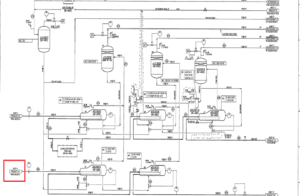
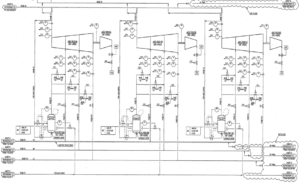

Various Stages of the C4 Refrigeration Unit Process
-
Natural Gas Compression
In the first stage, natural gas is compressed using powerful compressors to reach suitable pressures for entering the refrigeration system. The primary aim of this stage is to increase the gas pressure to facilitate proper cooling in subsequent processes.
Gas Input Pressure: The natural gas input pressure is approximately 1.63 MPa, essential for creating suitable heat transfer conditions in later stages.
Gas Input Temperature: The input gas temperature is about 40°C, which will be reduced to lower temperatures in the cooling stage to optimize liquefaction conditions.
Compression not only increases the gas pressure but also provides the potential energy required for subsequent processes.
-
Cooling and Heat Exchange
After compression, natural gas enters the cooling and heat exchange stage. In this stage, natural gas continuously contacts refrigerants through heat exchangers to reduce its temperature.
Gas Output Temperature from Heat Exchanger: After passing through the heat exchangers, the gas temperature decreases from 40°C to approximately 12.5°C.
The primary role of heat exchangers in this stage is to reduce the gas temperature sufficiently for the subsequent phase separation to occur.
-
Phase Separation
In the phase separation stage, the various components present in natural gas are separated. Natural gas comprises various components, including C1, C2, C3, isobutane (Ic4), and normal butane (NC14), each having distinct boiling points and behaviors under pressure and temperature.
Mole Fraction of C3: In this project, the mole fraction of C3 in the output stream of this stage is 97.62%.
Heavier compounds such as isobutane (Ic4) and normal butane (NC14) are removed in this stage.
-
Conversion to Liquid
Ultimately, after passing through compression, cooling, and phase separation, natural gas reaches the final stage of conversion to liquid.
Final Temperature of the Liquid Gas: At this stage, the final temperature of the natural gas is reduced to -16°C, allowing for liquefaction.
Final Pressure of the Liquid Gas: The final pressure of the liquid gas reaches about 0.18 MPa.
Importance of the C4 Refrigeration Process in LNG Production
The C4 refrigeration unit plays a pivotal role in the overall LNG production process. The processes of compression, cooling, phase separation, and liquefaction are continuously executed in this unit, resulting in high purity and quality LNG production. Optimizing this process regarding energy consumption, operational pressures, and desired temperatures leads to reduced operational costs and increased process efficiency.
Energy Optimization in the C4 Refrigeration Unit
Significant efforts have been made to optimize energy consumption within the C4 refrigeration unit using Aspen HYSYS software and precise analysis of operational data.
– Energy Consumption in Compressors: By fine-tuning operating pressures and optimizing input temperatures to compressors, we achieved reduced energy consumption.
– Improvement of Heat Exchanger Efficiency: By properly adjusting the flow rates of refrigerants and natural gas, more effective heat exchange was realized in the heat exchangers.
Simulation and Optimization in Aspen HYSYS
Aspen HYSYS is one of the most powerful process engineering software programs, widely used in the oil, gas, and petrochemical industries, especially for the simulation and optimization of process units. By accurately modeling dynamic processes, it allows engineers to simulate all physical and chemical aspects of a system and fine-tune key parameters for optimization.
Process Simulation
In this project, the simulation using Aspen HYSYS was the foundational step in the process analysis. By employing advanced thermodynamic models, it accurately modeled all fluid characteristics and behaviors under various pressures and temperatures. Aspen HYSYS enables precise simulation of the operational conditions (such as pressure, temperature, mass flow rates, gas compositions) of the C4 refrigeration unit.
Sensitivity Analysis
Sensitivity analysis was a critical tool used in the simulation to evaluate small changes in various parameters (such as temperature, pressure, gas compositions) and their impact on the overall refrigeration unit’s performance.
Process Optimization
Upon completion of the simulation and sensitivity analysis, optimization was conducted with aims of maximizing yield and minimizing operational costs. This involved multi-objective optimizations, including reducing energy consumption and increasing production capacity.
Optimization Results and Comparison with Operational Data
The results obtained from optimization were compared with actual operational data of the system, demonstrating substantial improvements in system efficiency.
Conclusion
The simulation and optimization of the C4 refrigeration unit in Sonatrach’s gas liquefaction process using Aspen HYSYS has been a significant success for APIPCO, yielding notable improvements in process performance and operational cost reductions. The engineering team’s ability to conduct precise analysis and optimization of complex processes has been a key factor in this project’s success.
